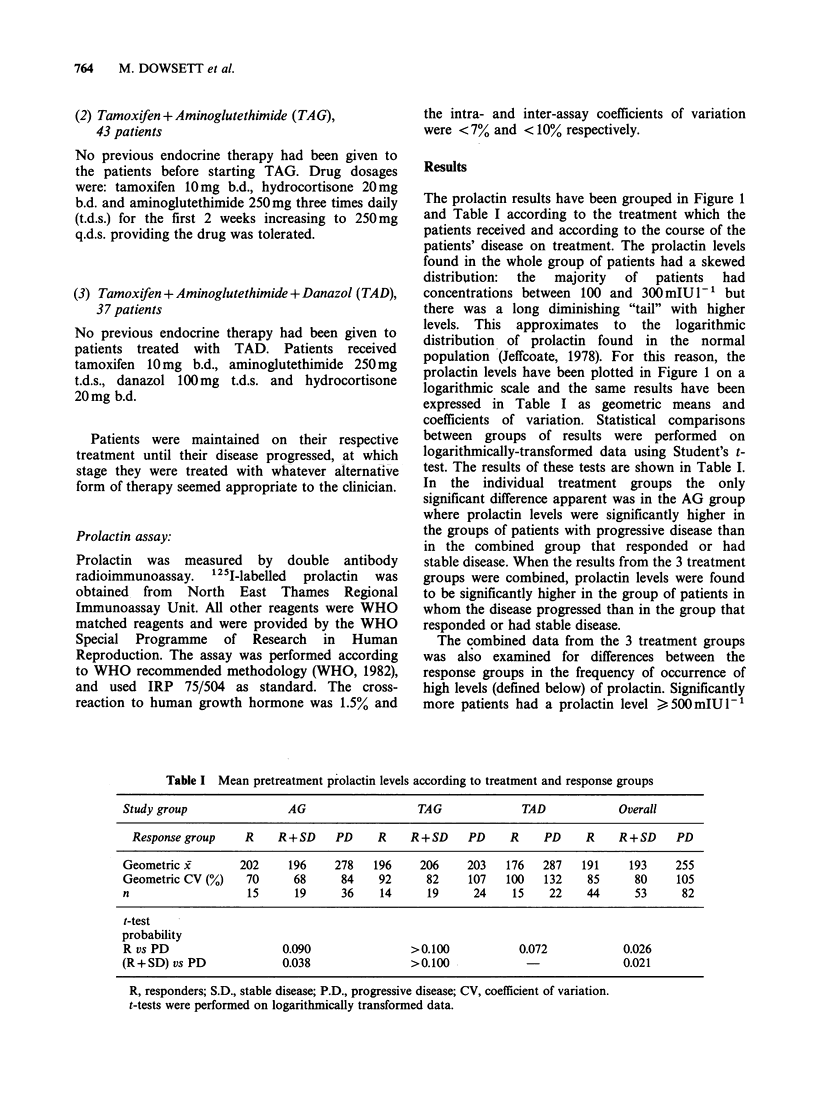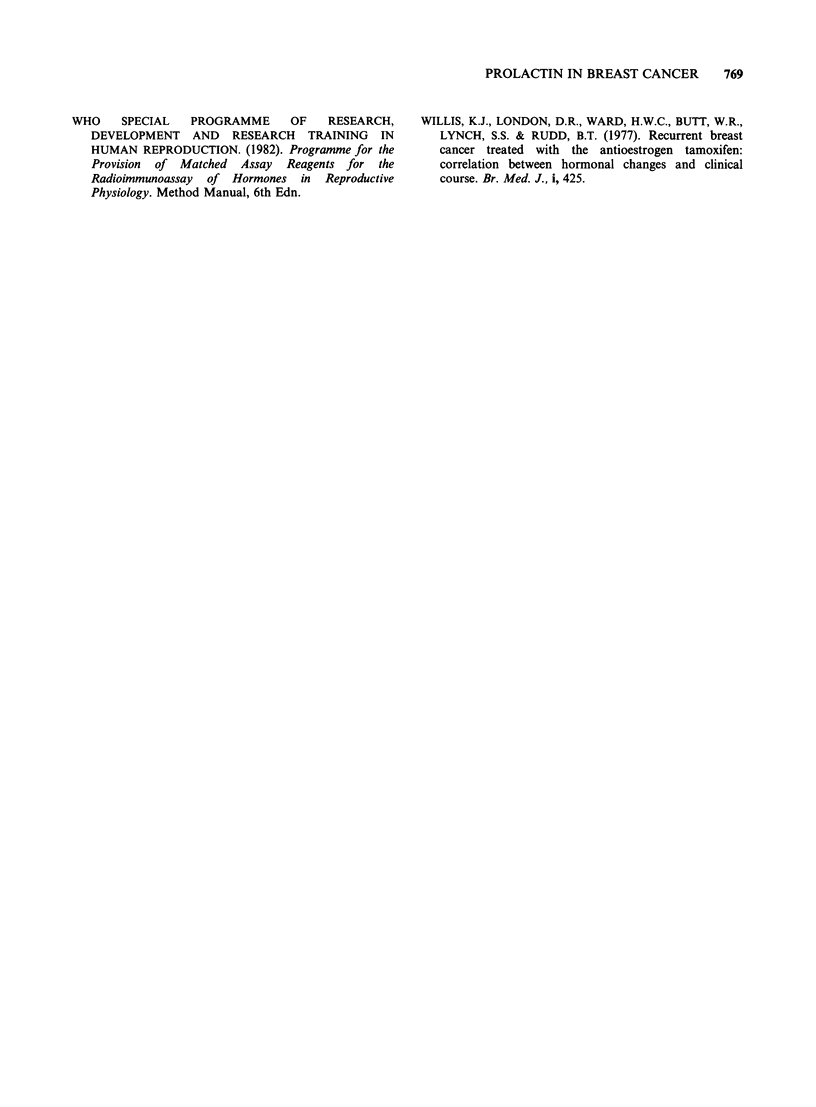Abstract
Serum prolactin concentrations were measured in 135 postmenopausal patients with advanced breast cancer prior to their treatment with one of 3 endocrine therapies: aminoglutethimide (AG), tamoxifen (T) + AG, or T + AG + danazol. The mean level of prolactin was higher, and there were more individuals with levels of prolactin greater than or equal to 500 mIUl-1, in the group of patients who did not respond to treatment. Of the patients whose disease progressed, those with prolactin levels greater than or equal to 500 mIUl-1 had a significantly shorter survival. It appears that high prolactin levels indicate a poor prognosis to endocrine therapy and the probability of a shorter than average survival time.
Full text
PDF






Selected References
These references are in PubMed. This may not be the complete list of references from this article.
- Cowden E. A., Ratcliffe W. A., Beastall G. H., Ratcliffe J. G. Laboratory assessment of prolactin status. Ann Clin Biochem. 1979 May;16(3):113–121. doi: 10.1177/000456327901600126. [DOI] [PubMed] [Google Scholar]
- Di Carlo R., Muccioli G. Prolactin receptor in human mammary carcinoma. Tumori. 1979 Dec 31;65(6):695–702. doi: 10.1177/030089167906500605. [DOI] [PubMed] [Google Scholar]
- Ehara Y., Siler T., VandenBerg G., Sinha Y. N., Yen S. S. Circulating prolactin levels during the menstrual cycle: episodic release and diurnal variation. Am J Obstet Gynecol. 1973 Dec 1;117(7):962–970. doi: 10.1016/0002-9378(73)90069-0. [DOI] [PubMed] [Google Scholar]
- Engelsman E., Heuson J. C., Blonk Van Der Wijst J., Drochmans A., Maass H., Cheix F., Sobrinho L. G., Nowakowski H. Controlled clinical trial of L-dopa and nafoxidine in advanced breast cancer: an E.O.R.T.C. study. Br Med J. 1975 Jun 28;2(5973):714–715. doi: 10.1136/bmj.2.5973.714. [DOI] [PMC free article] [PubMed] [Google Scholar]
- Harris A. L., Powles T. J., Smith I. E. Aminoglutethimide in the treatment of advanced postmenopausal breast cancer. Cancer Res. 1982 Aug;42(8 Suppl):3405s–3408s. [PubMed] [Google Scholar]
- Jeffcoate S. L. Diagnosis of hyperprolactinaemia. Lancet. 1978 Dec 9;2(8102):1245–1247. doi: 10.1016/s0140-6736(78)92112-8. [DOI] [PubMed] [Google Scholar]
- Koninckx P. Stress hyperprolactinaemia in clinical practice. Lancet. 1978 Feb 4;1(8058):273–273. doi: 10.1016/s0140-6736(78)90516-0. [DOI] [PubMed] [Google Scholar]
- Leung B. S., Sasaki G. H., Leung J. S. Estrogen-prolactin dependency in 7,12-dimethylbenz(a)anthracene-induced tumors. Cancer Res. 1975 Mar;35(3):621–627. [PubMed] [Google Scholar]
- Moult P. J., Dacie J. E., Rees L. H., Besser G. M. Prolactin pulsatility in patients with gonadal dysfunction. Clin Endocrinol (Oxf) 1981 Apr;14(4):387–394. doi: 10.1111/j.1365-2265.1981.tb00625.x. [DOI] [PubMed] [Google Scholar]
- Nagasawa H. Prolactin and human breast cancer: a review. Eur J Cancer. 1979 Mar;15(3):267–279. doi: 10.1016/0014-2964(79)90037-9. [DOI] [PubMed] [Google Scholar]
- Noel G. L., Suh H. K., Stone J. G., Frantz A. G. Human prolactin and growth hormone release during surgery and other conditions of stress. J Clin Endocrinol Metab. 1972 Dec;35(6):840–851. doi: 10.1210/jcem-35-6-840. [DOI] [PubMed] [Google Scholar]
- Pearce J. M., McGarrick G., Chamberlain G. V., Jeffcoate S. L. Lack of effect of interview and gynaecological examination on plasma levels of prolactin and cortisol. Br J Obstet Gynaecol. 1980 May;87(5):366–369. doi: 10.1111/j.1471-0528.1980.tb04560.x. [DOI] [PubMed] [Google Scholar]
- Smithline F., Sherman L., Kolodny D. Prolactin and breast carcinoma. N Engl J Med. 1975 Apr 10;292(15):784–792. doi: 10.1056/NEJM197504102921506. [DOI] [PubMed] [Google Scholar]
- Ward H. W. Combined anti-prolactin and anti-oestrogen therapy for breast carcinoma. Clin Oncol. 1977 Mar;3(1):91–95. [PubMed] [Google Scholar]
- Willis K. J., London D. R., Ward H. W., Butt W. R., Lynch S. S., Rudd B. T. Recurrent breast cancer treated with the antioestrogen tamoxifen: correlation between hormonal changes and clinical course. Br Med J. 1977 Feb 12;1(6058):425–428. doi: 10.1136/bmj.1.6058.425. [DOI] [PMC free article] [PubMed] [Google Scholar]


